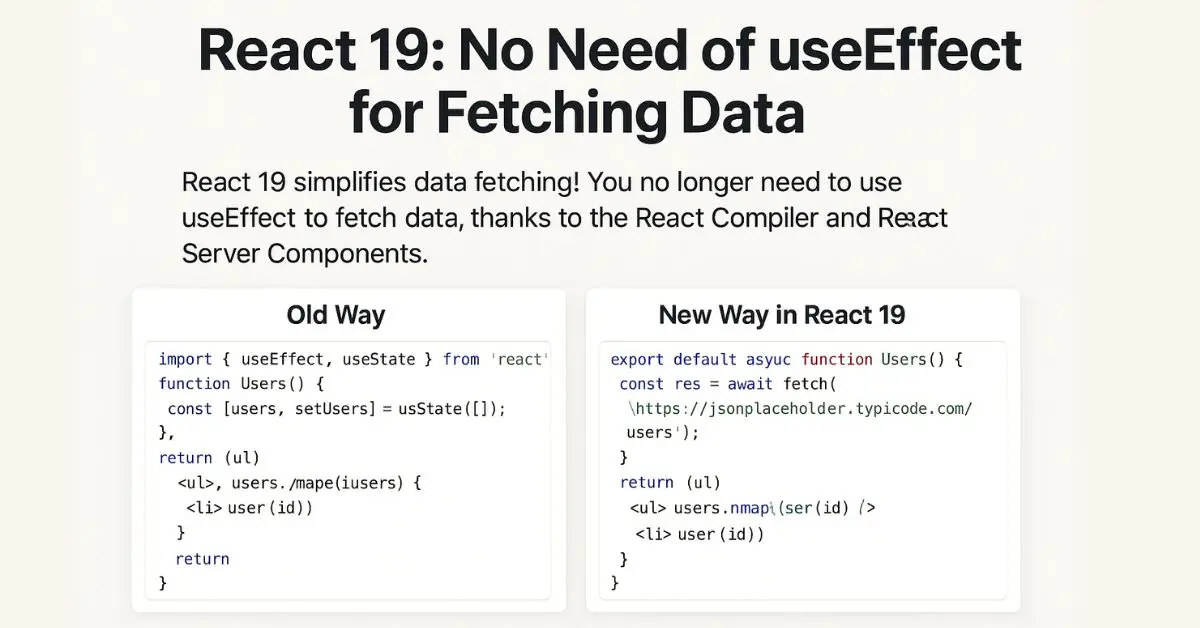React 19 is changing the way developers write front-end code—and one of the biggest shifts is how we handle data fetching. If you’re tired of juggling useEffect and managing state for API calls, this update is for you. With React 19, you no longer need useEffect to fetch data—thanks to the power of React Compiler and React Server Components.
The Old Way: useEffect and useState
Traditionally, fetching data in React looked like this:
import { useEffect, useState } from "react";
function Users() {
const [users, setUsers] = useState([]);
useEffect(() => {
fetch("/api/users")
.then((res) => res.json())
.then((data) => setUsers(data));
}, []);
return (
<ul>
{users.map((user) => (
<li key={user.id}>{user.name}</li>
))}
</ul>
);
}
This worked, but had problems:
- Multiple renders and state updates
- Difficult to handle errors or loading states cleanly
- Over-fetching or stale data issues
The New Way in React 19
React 19 introduces a compiler and async/await-based data fetching approach, especially when using Server Components or frameworks like Next.js App Router. Here’s how it simplifies the process:
// Users.jsx - React Server Component
export default async function Users() {
const res = await fetch("https://jsonplaceholder.typicode.com/users");
const users = await res.json();
return (
<ul>
{users.map((user) => (
<li key={user.id}>{user.name}</li>
))}
</ul>
);
}
No useEffect, no useState, no loading logic in the component. Just clean, async-first code.
Key Benefits
- Less Boilerplate: No more useEffect/useState combo for every fetch
- Better Performance: Data is fetched on the server, reducing client-side load
- Built-in Streaming Support: Components can progressively render with
Suspense - Automatic Caching: Frameworks like Next.js cache requests smartly
Does This Work in All React Projects?
Not exactly. This pattern shines when using React Server Components, which are available in:
- Next.js 14 App Router
- Future integrations with Vite, Remix, and other frameworks
For traditional Create React App (CRA) projects, you’ll still use useEffect unless you upgrade to server-rendering or adopt a compiler-based setup.
Conclusion
React 19 is moving toward a cleaner, more optimized future. By removing the need for useEffect in data fetching—especially in server-rendered environments—it helps you focus on building features, not wiring up logic.
If you’re building a modern React app in 2025, now’s the time to explore React Server Components and React 19 features.
Want to learn more about React’s future?
Check out our deep-dive guides on Makemychance.com, where we explore everything from React fundamentals to cutting-edge updates.
Arsalan Malik is a passionate Software Engineer and the Founder of Makemychance.com. A proud CDAC-qualified developer, Arsalan specializes in full-stack web development, with expertise in technologies like Node.js, PHP, WordPress, React, and modern CSS frameworks.
He actively shares his knowledge and insights with the developer community on platforms like Dev.to and engages with professionals worldwide through LinkedIn.
Arsalan believes in building real-world projects that not only solve problems but also educate and empower users. His mission is to make technology simple, accessible, and impactful for everyone.



